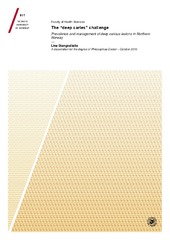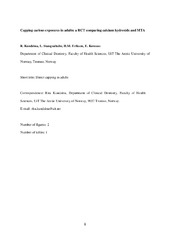| dc.contributor.advisor | Kundzina, Rita | |
| dc.contributor.author | Stangvaltaite, Lina | |
| dc.date.accessioned | 2015-12-09T15:13:58Z | |
| dc.date.available | 2015-12-09T15:13:58Z | |
| dc.date.issued | 2015-10-22 | |
| dc.description.abstract | The overall aim of this doctoral thesis was to increase the understanding and knowledge of the prevalence and management of deep carious lesions. The prevalence of dental caries in Norway was among the highest in the world in the middle of 20th century. Though it has significantly declined, there are indications that the prevalence of caries in Northern Norway is higher than in the rest of the country. A higher prevalence of caries might lead to a higher prevalence of deep carious lesions. Study I focused on the prevalence of deep carious lesions and other consequences of caries (DCL-CC) among 18-year-olds enrolled in the Public Dental Health Service in Northern Norway. There were 488 (26%) subjects having at least one molar with DCL-CC. The mean decayed, missing, and filled teeth (DMFT) (SD) score among these 488 subjects was 9.1 (4.6), twice as high as among subjects without DCL-CC (4.5, SD 4.0). The most prevalent modality among untreated deep carious lesions, deep restorations, root canal obturated molars, and molars extracted due to caries were deep restorations, which were observed among 21.5% (n=404) of the age cohort. Root canal obturated molars, molars extracted due to caries, and untreated deep carious lesions were prevalent in 5.1%, 3.6% and 1.6% of this age cohort, respectively. The high prevalence of DCL-CC in Northern Norway is of concern and presents a challenge for dentists, as no treatment guidelines exist for deep carious lesions. Study II was a questionnaire study that investigated the preferred treatment methods of general dental practitioners in Northern Norway for deep carious lesions and carious exposures in mature permanent teeth. Study II underlined the lack of uniformity in preferred treatment methods among the respondents, and the inconsistency of these methods with those suggested in the current literature. For example, in the absence of symptoms, total caries excavation was favored by a majority of respondents (49%), while in presence of symptoms (indicating reversible pulpitis at most), pulpectomy followed by endodontic treatment was the preferred treatment method for 39% of respondents. Direct pulp capping (DPC), mainly with calcium hydroxide (CH), was the most preferred treatment method (51%) for carious exposures in the absence of symptoms, although it is still a controversial treatment method for adults. In Study III, a promising capping material, mineral trioxide aggregate (MTA), was tested against the gold standard material CH for DPC on carious exposures in adults. After 2-3 years of follow-up, the estimated cumulative survival rate for molars capped with MTA was statistically significantly higher (80%) then for molars capped with CH (46%) (p=0.018). The study is still ongoing, but there are indications that it may provide evidence that will change the established recommendations for the treatment of carious exposures in adults. | en_US |
| dc.description.doctoraltype | ph.d. | en_US |
| dc.description.popularabstract | En av fire 18-åringer i Troms Fylke har behandlede eller ubehandlede dype hull – diagnosen med ingen klare retningslinjer for behandling. Denne aldersgruppen skal forlate oppfølgingen de inntil nå har fått gratis fra Den offentlige tannhelsetjenesten, og må i fremtiden selv både oppsøke og betale offentlige eller private tannklinikker for oppfølging og behandling. Dette var grunnlaget for at Lina Stangvaltaite ønsket å undersøke hvordan tannleger i Nord-Norge behandler tenner med dype hull. Resultatet var likt som i liknende undersøkelser i andre land: tannleger er ikke enige i hva som er den beste behandlingen for tenner med dype hull. Uenigheten bunner trolig i mangelen på vitenskapelige bevis, spesielt hva gjelder voksne pasienter. Det ble derfor også undersøkt om et av de nye materialene på markedet (MTA) er mer effektivt enn det materialet mange tannleger bruker i dag for å unngå rotfylling. Ved bruk av det nye materialet overlevde dobbelt så mange tenner som ved bruk av det vanligst brukte materialet. | en_US |
| dc.description | Papers number I and II of this thesis are not available in Munin:<br>Paper I. Deep carious lesions and other consequences of caries among 18-year-olds at Public Dental Health Service in Northern Norway: a cross-sectional age cohort study. Stangvaltaite L., Kundzina R., Bolstad N.L., Eriksen H.M., Kerosuo E. Available in <a href=http://dx.doi.org/10.3109/00016357.2014.971866>Acta Odontologica Scandinavica, vol. 73, issue 6, 2015</a><br>Paper II. Treatment preferences of deep carious lesions in mature teeth: questionnaire study among dentists in Northern Norway. Stangvaltaite L., Kundzina R., Eriksen H.M., Kerosuo E. Available in <a href=http://dx.doi.org/10.3109/00016357.2013.775338>Acta Odontologica Scandinavica, vol. 71, issue 6, 2013</a> | en_US |
| dc.identifier.uri | https://hdl.handle.net/10037/8295 | |
| dc.identifier.urn | URN:NBN:no-uit_munin_7876 | |
| dc.language.iso | eng | en_US |
| dc.publisher | UiT The Arctic University of Norway | en_US |
| dc.publisher | UiT Norges arktiske universitet | en_US |
| dc.rights.accessRights | openAccess | |
| dc.rights.holder | Copyright 2015 The Author(s) | |
| dc.rights.uri | https://creativecommons.org/licenses/by-nc-sa/3.0 | en_US |
| dc.rights | Attribution-NonCommercial-ShareAlike 3.0 Unported (CC BY-NC-SA 3.0) | en_US |
| dc.subject | dentistry | en_US |
| dc.subject | odontology | en_US |
| dc.subject | carious exposure | en_US |
| dc.subject | MTA | en_US |
| dc.subject | VDP::Medisinske Fag: 700::Klinisk odontologiske fag: 830 | en_US |
| dc.subject | VDP::Medical disciplines: 700::Clinical dentistry disciplines: 830 | en_US |
| dc.title | The "deep caries" challenge. Prevalence and management of deep carious lesions in Northern Norway. | en_US |
| dc.type | Doctoral thesis | en_US |
| dc.type | Doktorgradsavhandling | en_US |


 English
English norsk
norsk

